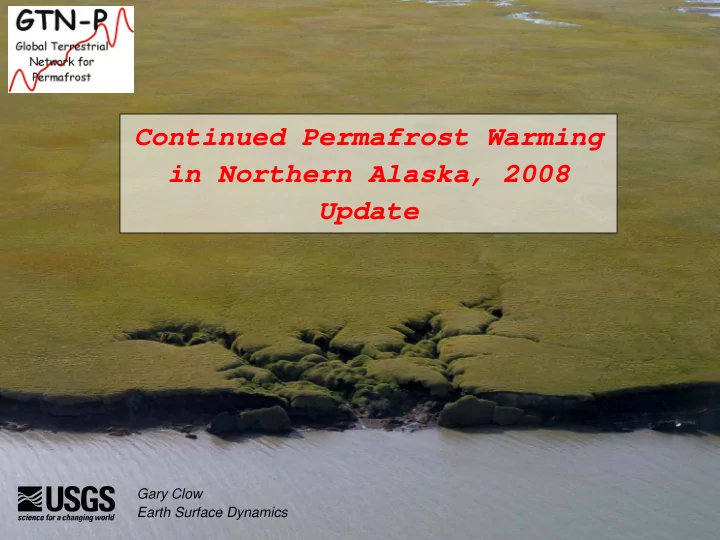

Continued Permafrost Warming in Northern Alaska, 2008 Update Gary Clow Earth Surface Dynamics
GCOS Ocean Terrestrial Observing Observing Atmospheric Systems Systems Observing Systems Essential Climate Variables: …. • permafrost - active layer thickness (GTN-P) • permafrost - thermal state (GTN-P) ….
Permafrost Zones Alaska Active Layer Permafrost Continuous Permafrost Discontinuous Permafrost
Permafrost Zones Alaska Active Layer Permafrost T air = -8 ° C mean-annual T g = -5 ° C Continuous Permafrost Discontinuous Permafrost
GTN-P: Thermal State of Permafrost
ANWR ANWR DOI / GTN-P -A A NPR- NPR
Borehole Array DOI/GTN-P Atigaru Point Arctic Ocean measuring circuit located in a thermally controlled Faraday cage Temperatures are periodically remeasured in the DOI/GTN-P boreholes using the USGS’s Polar Temperature Logging System. System sensitivity is ~ 0.2 mK, uncertainty = 3.3 mK.
Borehole Array Permafrost Temperatures: East Teshekpuk DOI/GTN-P Teshekpuk Lake Well Temperatures at East Teshepuk about 1.6 years after borehole completion.
Permafrost Temperatures: East Teshekpuk Borehole Array DOI/GTN-P
Permafrost Temperatures: East Teshekpuk Borehole Array DOI/GTN-P
Permafrost Temperatures: East Teshekpuk Borehole Array DOI/GTN-P
Borehole Array Permafrost Temperatures: East Teshekpuk DOI/GTN-P Northern Alaska experienced a mild cooling during 1983-84. Just a hint of that cooling is visible in the 1984 East Teshekpuk log (it’s much more apparent at other sites).
Borehole Array Permafrost Temperatures: East Teshekpuk DOI/GTN-P Temperature logs acquired during 1989 began to show a recovery from the mid-1980’s cooling.
Permafrost Temperatures: East Teshekpuk Borehole Array DOI/GTN-P
Borehole Array Permafrost Temperatures: East Teshekpuk DOI/GTN-P The climate record during the 1990’s was clearly different from that during the 80’s and late 70’s.
Permafrost Temperatures: East Teshekpuk Borehole Array DOI/GTN-P
Borehole Array Permafrost Temperatures: East Teshekpuk DOI/GTN-P Measured temperature profiles with preliminary extrapolated surface temperatures. Surface temperatures were ~ 3.6 ° C warmer during 2007 than during the late-70’s, early-80’s.
Borehole Array Permafrost Temperatures: South Meade DOI/GTN-P South Meade Surface temperatures were ~ 4.6 ° C warmer at South Meade during 2007 than during the late-70’s, early-80’s.
Borehole Array DOI/GTN-P Mean-Annual Surface Temperatures ( ° C), 1989 -8.1 -10.2 -10.2 -9.3 -9.6 -9.8 -9.7 -10.6 -8.8 -9.8 -7.0 NPR- -A A NPR Brooks Range Arctic Coastal Plain (ACP) was well within the Continuous Permafrost Zone in 1989 (T g < -5 ° C).
Borehole Array DOI/GTN-P Mean-Annual Surface Temperatures ( ° C), 2007 -4.4 -6.5 -8.3 -5.8 -7.7 -7.5 -4.6 -6.4 -4.5 -6.3 -6.5 -5.5 -4.5 NPR- -A A NPR -4.2 Brooks Range By 2007, surface conditions at some locations on the ACP were approaching those that occur at the Continuous / Discontinuous permafrost boundary (T g = -5 ° C). [Δ T = 3.5 ° C]
Borehole Array DOI/GTN-P Mean-Annual Surface Temperatures ( ° C), 2007 -4.4 -6.5 -8.3 -5.8 -7.7 -7.5 -4.6 -6.4 -4.5 -6.3 -6.5 -5.5 -4.5 NPR- -A A NPR -4.2 -4.3 Brooks Range T air = -8 ° C T g = -5 ° C By 2007, surface conditions at some locations on the ACP were approaching those that occur at the Continuous / Discontinuous permafrost boundary (T g = -5 ° C).
Ice-Wedge Degradation Ice Wedges Arctic Coastal Plain NPR-A • Take 1000s of years to form. • Have been stable on the ACP for > 3000 years T. Jorgenson thermokarst pit Jorgenson et al., GRL, 2006
Ice-Wedge Degradation Arctic Coastal Plain Jorgenson et al., GRL, 2006 T. Jorgenson area of thermokarst pits = 0.5% 0.6% 4.4% = 88/km 2 128/km 2 1336/km 2 density of pits • Area/density of thermokarst pits abruptly increased an order of magnitude after 1982; an event of similar magnitude probably hasn’t occurred in the past 3,000 years. • Enhanced degradation was due to warmer summer temperatures during 1989-1998. • Degradation of ice wedges has caused a substantial redistribution of surface water from the adjacent tundra into the degraded trough network. • If the trend continues, 10-30% of the terrestrial landscape may be directly effected.
Permafrost Degradation Arctic Alaska thaw slump August, 2004 changing shoreline environment
Mean-August Temperature Profiles Fish Creek 2004: a particularly warm summer Thawing-Degree-Days Maximum Active-Layer Depth
July 2003 J.W. Dalton Wellsite Coastal Erosion 1998 Arctic Alaska Sept 2004 = 100 m Erosion July 2001 Aug 2003 July 2003 = 35 m Erosion S. Flora, BLM Susan Flora, BLM August, 2003 Sept 2004 Wind Speed, AK102 S. Flora, BLM
Coastal Erosion - Drew Point, Arctic Coast Ben Jones , USGS
Permafrost Degradation - Arctic Alaska ice wedges, advanced degradation Bruce Richmond , USGS
Permafrost Degradation - Arctic Alaska thermokarst gully Bruce Richmond , USGS
Permafrost Degradation - Arctic Alaska Bruce Richmond , USGS
Permafrost Degradation - Arctic Alaska thaw slump increased sediment flux from melting permafrost Bruce Richmond , USGS
JWD well 40 km Drew Point Point Barrow
Thank you!
Near-Surface Temperatures at Near-Surface Permafrost Temperatures East Teshekpuk, NPR-A East Teshekpuk, NPRA -6 -7 Temperature (°C) -8 -9 -10 -11 1975 1980 1985 1990 1995 2000 2005 2010 Year
Mean-July Air Temperature ( ° C) Future vegetation changes? Fish Creek Fish Creek - AK102 DOI/GTN-P monitoring network station AK102
DOI / GTN-P Active-Layer Network 1) Automated Permafrost / Climate-Monitoring Stations NPR- -A A NPR ANWR ANWR Research + Operational Network
GCOS/GTOS/GTN-P Station U31 Marsh Creek, ANWR • ground temperature (10 depths) • soil moisture • air temperature • pressure* • wind speed & direction • rain* • snow depth • up- and downwelling shortwave radiation • albedo
GCOS Ocean Terrestrial Observing Observing Atmospheric Systems Systems Observing Systems GEOSS
Recommend
More recommend